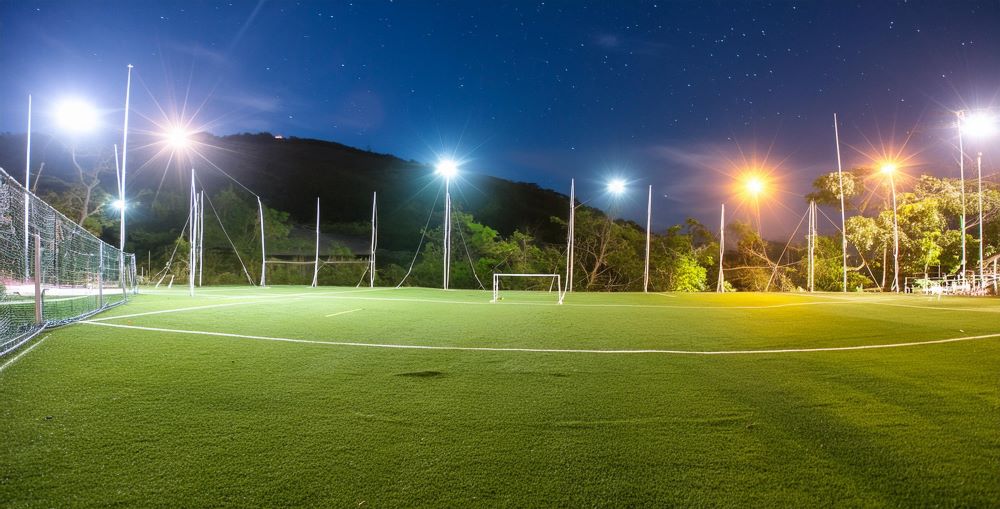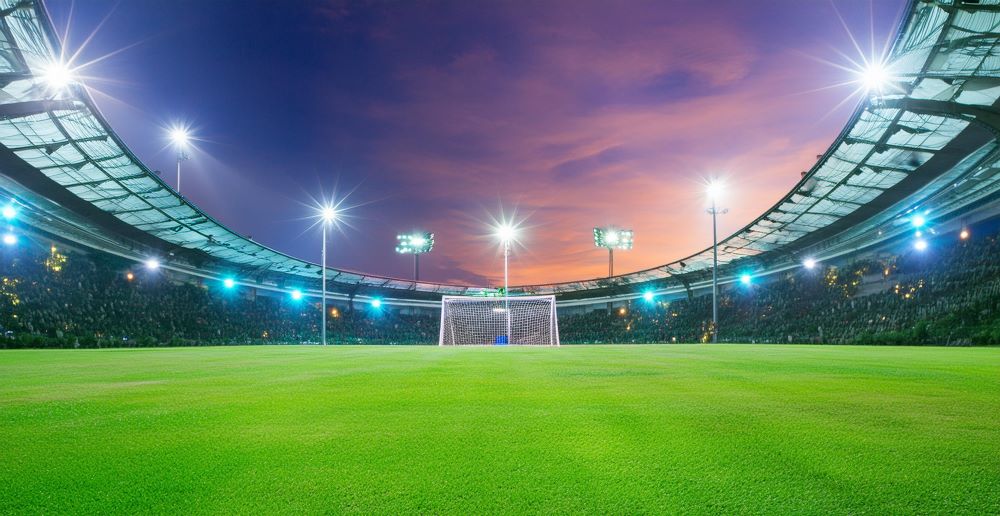Definition of stadium floodlights
Stadium floodlights are expansive lighting systems strategically installed within sports venues to illuminate playing areas during events. These fixtures are pivotal in ensuring optimal visibility for players, officials, and spectators, serving as a cornerstone of the sports experience. Visibility holds paramount importance in sports, influencing various facets of the game. For players, clear visibility facilitates tracking the ball, anticipating movements, and executing precise actions crucial for performance. Additionally, it plays a crucial role in enhancing safety by minimizing the risk of collisions and injuries among players. Furthermore, clear visibility enhances the overall spectator experience, allowing fans attending live events or watching broadcasts to fully immerse themselves in the excitement of the game. Thus, stadium floodlights play a vital role in shaping the atmosphere and dynamics of sports engagements.
Contents
Components of Stadium Floodlights
Light Sources
Stadium floodlights rely on various types of bulbs to illuminate sports venues, with the most common being HID (High-Intensity Discharge) and LED (Light-Emitting Diode) bulbs. HID bulbs are renowned for their high luminous efficacy and long lifespan, while LEDs offer exceptional energy efficiency and durability. Each type of bulb brings unique characteristics and benefits to stadium lighting systems, catering to different needs and preferences.
Reflectors and Optics
Reflectors play a crucial role in stadium floodlights by directing and controlling the distribution of light emitted from the bulbs. These components ensure that light is efficiently directed towards the playing surface, minimizing glare and shadows to optimize visibility for athletes and spectators. Additionally, advanced optical systems are integrated into floodlight designs to further reduce glare and shadows, creating a well-lit environment conducive to sports activities.
Mounting and Positioning
Elevated mounting positions are essential for stadium floodlights to achieve comprehensive coverage of the playing field. By positioning the floodlights at strategic heights surrounding the venue, lighting designers can ensure uniform illumination across the entire playing surface. Moreover, considerations for the stability and adjustability of floodlight fixtures are crucial to guarantee precise aiming and coverage. This enables lighting engineers to fine-tune the direction and intensity of light as needed, accommodating various sports events and venue configurations with optimal precision.

Factors Affecting Visibility
Ambient Light Conditions
Stadium floodlights play a crucial role in compensating for varying levels of natural light, particularly during twilight or nighttime events when daylight diminishes. Lighting engineers employ strategic strategies to adjust floodlight intensity and distribution, ensuring seamless integration with ambient light conditions. By carefully balancing floodlight output with natural light, they can enhance visibility on the field while minimizing harsh contrasts or glare that may hinder player performance or spectator experience.
Environmental Factors
Weather conditions such as rain, fog, or snow pose significant challenges to visibility on the field. Stadium floodlights must contend with these environmental factors by implementing measures to mitigate glare and reflection from surrounding surfaces. Advanced lighting technologies and design considerations are employed to minimize the impact of adverse weather, ensuring clear visibility for players and spectators alike, even in inclement conditions.
Time of Day Considerations
Daytime events in enclosed venues present unique challenges due to limited natural light penetration. Stadium floodlights are instrumental in overcoming these challenges by providing adequate illumination throughout the venue. Additionally, during dusk or dawn events, floodlights seamlessly integrate with natural lighting conditions to maintain consistent visibility. By synchronizing floodlight operation with the changing light levels, lighting designers ensure optimal visibility for all stakeholders, regardless of the time of day.

Brightness and Uniformity
Stadium floodlights are engineered to provide high-intensity illumination across the playing surface, ensuring optimal visibility for players, officials, and spectators. These luminaires emit powerful beams of light that effectively illuminate the entire field, allowing for clear visibility of all aspects of the game, from players to the ball in play. The intensity of the illumination is carefully calibrated to meet the specific lighting requirements of the venue, ensuring that every corner of the field is adequately lit for optimal performance and safety.
Achieving uniform light distribution is paramount in stadium lighting design to eliminate dark spots and ensure consistent visibility across the playing surface. Dark spots can create uneven lighting conditions, leading to potential safety hazards and affecting player performance. By ensuring uniform light distribution, stadium floodlights eliminate shadows and ensure that all areas of the field are equally visible, providing players with the confidence to perform at their best and enhancing the overall quality of the sports experience for spectators.
Glare Reduction
Various techniques and technologies are employed in stadium lighting systems to minimize glare and discomfort for players and spectators. Anti-glare coatings on fixtures and precision optics help to diffuse light and reduce glare, ensuring that players can perform at their best without being distracted or hindered by excessive brightness. Additionally, shielding and baffles are used to control the direction of light spill, minimizing glare and enhancing the overall quality of illumination on the playing surface.
Controlling light spill is essential in preventing distractions and enhancing focus during gameplay. By directing light precisely where it is needed and minimizing spillage onto surrounding surfaces, stadium floodlights ensure that players can concentrate fully on the game without being distracted by stray light or glare. This not only improves the quality of play but also enhances the overall spectator experience, allowing fans to fully immerse themselves in the excitement of the game without being hindered by glare or discomfort.
Color Rendering and Contrast Enhancement
Floodlights in stadiums are designed to optimize color temperature and contrast to improve the visibility of objects and players on the field. By carefully adjusting the color temperature of the light emitted, stadium floodlights ensure that colors appear vibrant and true to life, allowing players to distinguish between different elements of the game with ease. Additionally, contrast enhancement techniques are employed to improve the clarity and definition of objects on the field, enhancing overall visibility and improving the quality of the sports experience for players and spectators alike.
Enhancing depth perception and object recognition through effective lighting design is crucial in stadium environments. By creating a visually stimulating and immersive atmosphere, stadium floodlights enhance the overall quality of the sports experience, allowing players to perform at their best and spectators to fully appreciate the action on the field. Through careful attention to color rendering and contrast enhancement, stadium lighting designers ensure that every aspect of the game is brought to life with clarity and precision, creating an unforgettable experience for all involved.
Adaptability and Control Systems
Customization for Different Sports and Events
Stadium floodlights exhibit a high degree of flexibility, allowing for the adjustment of floodlight configurations to meet the specific requirements of different sports. Whether it’s a fast-paced soccer match, a precision-focused tennis match, or a high-flying basketball game, floodlights can be tailored to provide optimal illumination tailored to the unique characteristics of each sport. This adaptability ensures that athletes have the visibility they need to perform at their best and that spectators can fully engage with the action on the field.
Dynamic control systems are integral to the adaptability of stadium floodlights, enabling real-time adjustments based on event scheduling and environmental conditions. With these sophisticated systems, lighting operators can easily modify the intensity, direction, and timing of floodlighting to accommodate changes in event timing, weather conditions, or other unforeseen circumstances. This dynamic control ensures that lighting conditions remain optimal throughout the duration of the event, enhancing the overall experience for both participants and spectators.
Remote Control and Monitoring
Advanced control systems are employed for the remote operation and monitoring of stadium floodlight fixtures, offering unprecedented convenience and efficiency for lighting operators. Through remote interfaces, operators can easily adjust floodlight settings from a centralized location, eliminating the need for manual adjustments on-site. Additionally, these systems enable real-time monitoring of floodlight performance, allowing operators to promptly address any issues or anomalies that may arise during the event.
Monitoring of energy usage and performance metrics is an essential aspect of optimizing the efficiency and effectiveness of stadium floodlighting. By tracking energy consumption and performance indicators such as light output and uniformity, operators can identify opportunities for optimization and implement strategies to enhance lighting efficiency without compromising visibility or safety. This proactive approach to monitoring ensures that stadium floodlights operate at peak performance levels while minimizing energy costs and environmental impact.
Integration with Venue Operations
Stadium floodlights are seamlessly integrated with other systems within the venue, such as audiovisual equipment and facility management systems, to enhance operational efficiency and coordination. Through interoperability with venue infrastructure, floodlighting systems can be synchronized with other event elements, such as scoreboard displays or music systems, to create a cohesive and immersive experience for spectators.
Collaboration with venue operators and event organizers is essential to ensuring the seamless integration of floodlighting solutions with overall venue operations. By working closely with stakeholders, lighting designers can understand the specific requirements and constraints of each event and tailor floodlighting solutions accordingly. This collaborative approach ensures that floodlighting systems not only meet the technical specifications of each event but also contribute to the overall success and enjoyment of the venue experience for all involved parties.
Conclusion
Stadium floodlights play a critical role in enhancing visibility and optimizing sports performance on the field. By providing high-intensity illumination and ensuring uniform light distribution, floodlights enable players to track the ball, anticipate movements, and execute precise maneuvers with confidence. Moreover, floodlights contribute to the safety of athletes by reducing the risk of collisions and injuries, while also enhancing the overall spectator experience by providing clear visibility for fans attending live events or watching broadcasts.
Ongoing advancements in lighting technology and design continue to drive innovation in stadium floodlights, ensuring that they meet the evolving needs and challenges of the sports industry. From energy-efficient LED technologies to sophisticated control systems, these advancements enable floodlights to deliver superior performance, efficiency, and versatility, enhancing their effectiveness in various sports venues and environments.
Collaboration between lighting experts, sports organizations, and venue operators is essential to creating optimal visibility solutions that enhance the overall sports experience. By working together, stakeholders can leverage their expertise and resources to design and implement floodlighting solutions that meet the specific requirements of each venue and event. This collaborative approach ensures that stadium floodlights not only meet technical specifications but also contribute to creating memorable and engaging experiences for athletes and spectators alike, reinforcing the importance of teamwork in achieving success on and off the field.

